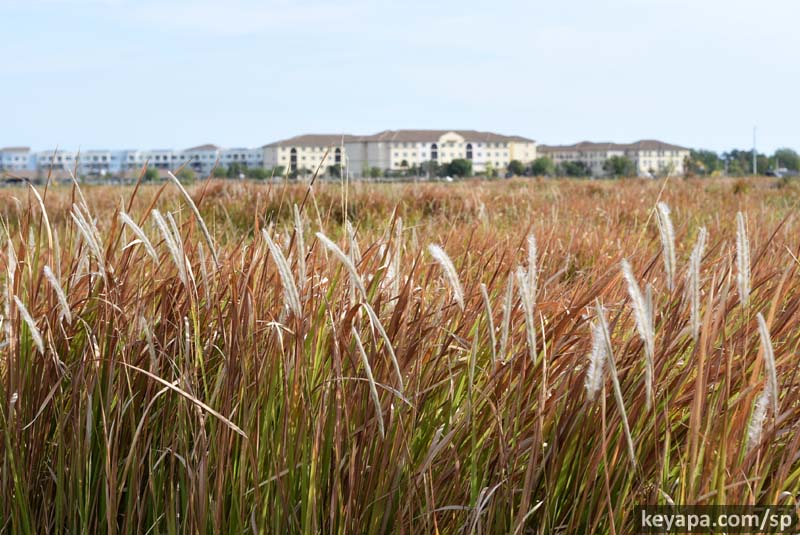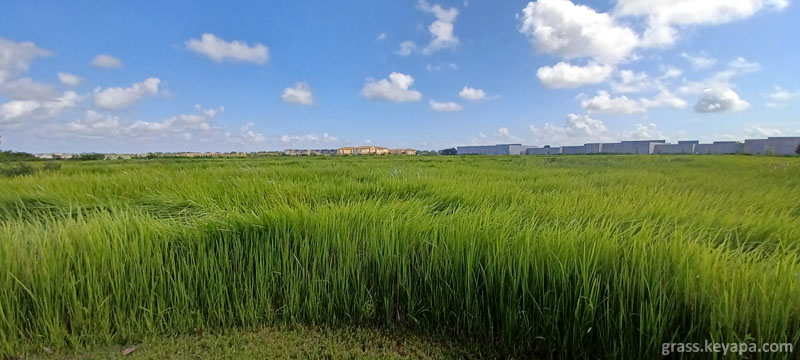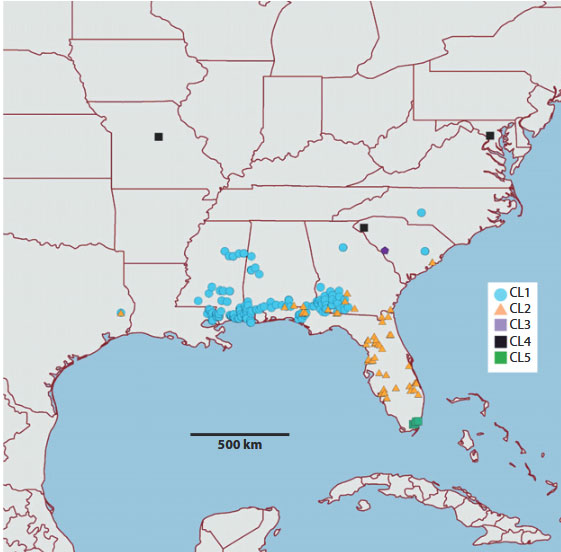
Three years ago, I chronicled the invasion of an island in a parking lot by Imperata cylindrica (cogon grass), and how the property owners removed all vegetation from the affected island a few months later. This included two trees that probably were affected by whatever herbicide they used.
Throughout the years, the island had remained bare, and when I visited the parking lot again a few weeks ago (late March 2025), I was not surprised to find that nothing had changed.
I was about to leave and drive off when by chance I glimpsed something on the next island over. There were bright green blades of grass rising from a cluster of Muhlenbergia ornamentals on that parking island! This was a sure sign of the presence of the nefarious I. cyindrica, and this made me wonder whether the owners of the property will again completely eradicate all vegetation in the new island.

The appearance of I. cylindrica in the isolated second island might also have some interesting implications. Since studies seem to indicate that cogon in Florida do not to normally reproduce sexually, unless there were some landscape additions made to that island which contained parts of cogon rhizomes, the new I. cylindrica infestation could only have arrived by seed.

This is because I. cylindrica is self-incompatible, which means that in order to produce viable seeds a population can only spread vegetatively until it encounters another clonal lineage. Since it was hypothesized that I. cylindrica mainly spreads by the distribution of rhizomes in Florida and not by seeds (Willard et al, 1990), the Florida population may have been derived from a single genetic clone.
This seems to have been confirmed in 2015, when a study showed that the bulk of Central Florida is composed of only one clonal lineage (Burrell et al, 2015), bolstering the argument that cogon in the area reproduces and spreads mainly by rhizome dispersal.

This is very fortunate, because seed germination tends to be very high in the species, with more than 95% of seeds germinating in a Mississippi study (Burnell et al, 2003). However, no dormancy mechanisms have been shown in cogon grass seeds, and viability seems to decline rapidly, with almost all seeds not viable after only one year (MacDonald, 2007). In addition, seed production also seems to be highly variable. In Alabama, for example, some locations can have higher seed production (up to 37% of florets produce seeds), whereas in other locations (especially towards the north), seed production is low (zero to 2% of florets produce seeds) (Lowenstein).
So the sudden appearance of cogon grass in the isolated second island intrigues me, because it may be evidence of the rare production and germination of cogon seeds in Central Florida. I’ll be sure to take a closer look at it the next time I am in the vicinity. Perhaps there may be a simpler answer, and the introduction was the result of some new addition by the landscapers to the island, which unfortunately had some cogon rhizomes in it. Stay tuned.
Literature Cited:
Burnell, K.D., J.D. Byrd, Jr., and P.D. Meints (2003). Evaluation of plant growth regulators for Cogongrass [Imperata cylindrica (L.) Beauv.] seed development and control. Proc. South. Weed Sci. Soc. 56:342
Burrell, A. Millie, et al. (2015). “Exploring origins, invasion history and genetic diversity of Imperata cylindrica (L.) P. Beauv.(Cogongrass) in the United States using genotyping by sequencing.” Molecular Ecology 24.9: 2177-2193.
Loewenstein NJ. COGONGRASS: FLOWERING AND SPRING CONTROL OPTIONS. Alabama Cooperative Extension info sheet
MacDonald, G.E. (2007). “Cogongrass (Imperata cylindrica): Biology, Distribution and Impacts in the Southeastern U.S. In: A Cogongrass Management Guide.” Loewenstein N.J. and J.H. Miller eds. Alabama Cooperative Extension System, Auburn School of Forestry and Wildlife Sciences, US Dept. Agric. Forest Service. Nov. 7–8, 2007. Mobile Alabama.
Willard, T. R., D. W. Hall, D. G. Shilling, J. A. Lewis, and W. L. Currey. 1990. Cogongrass (Imperata cylindrica) distribution on Florida highway rights-of-way.
Weed Technol. 4:658-660

Leave a Reply